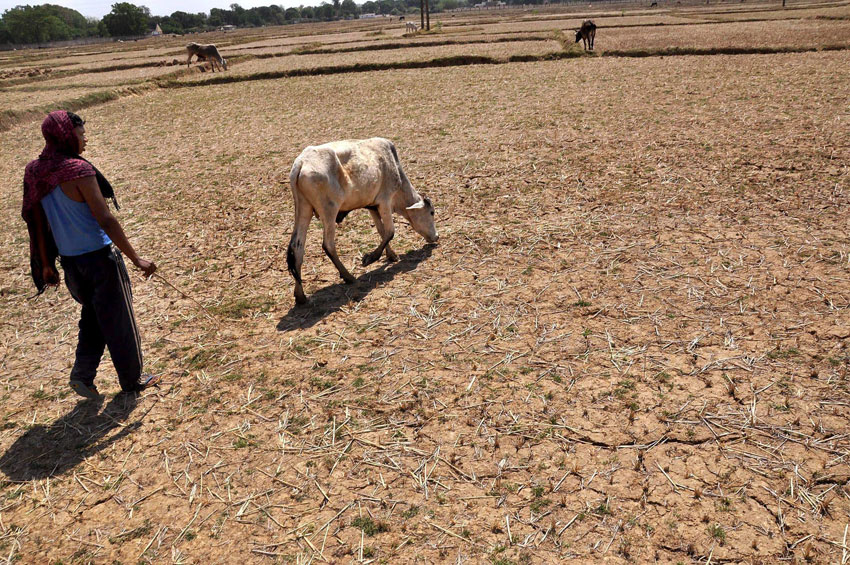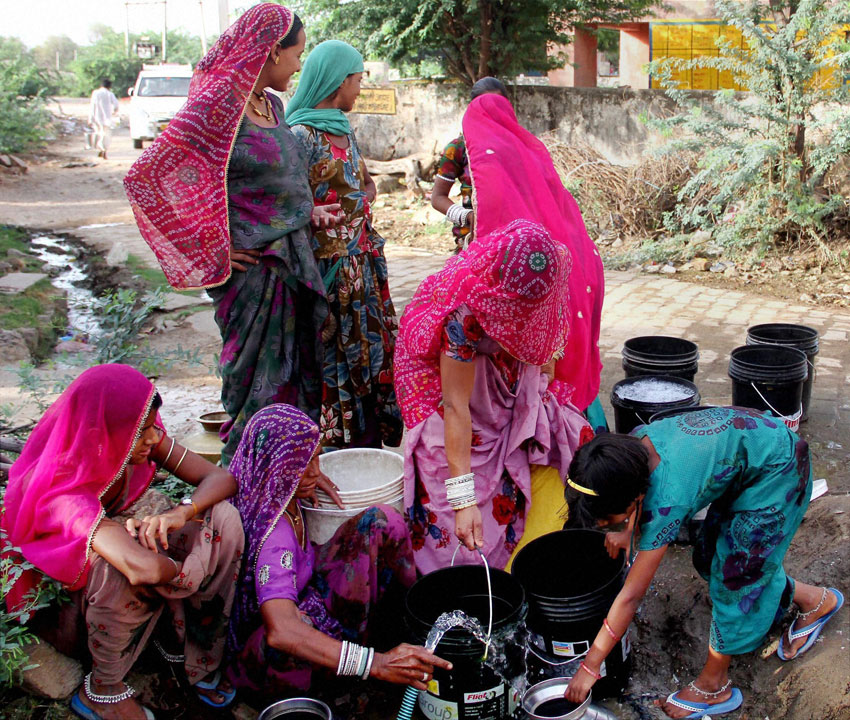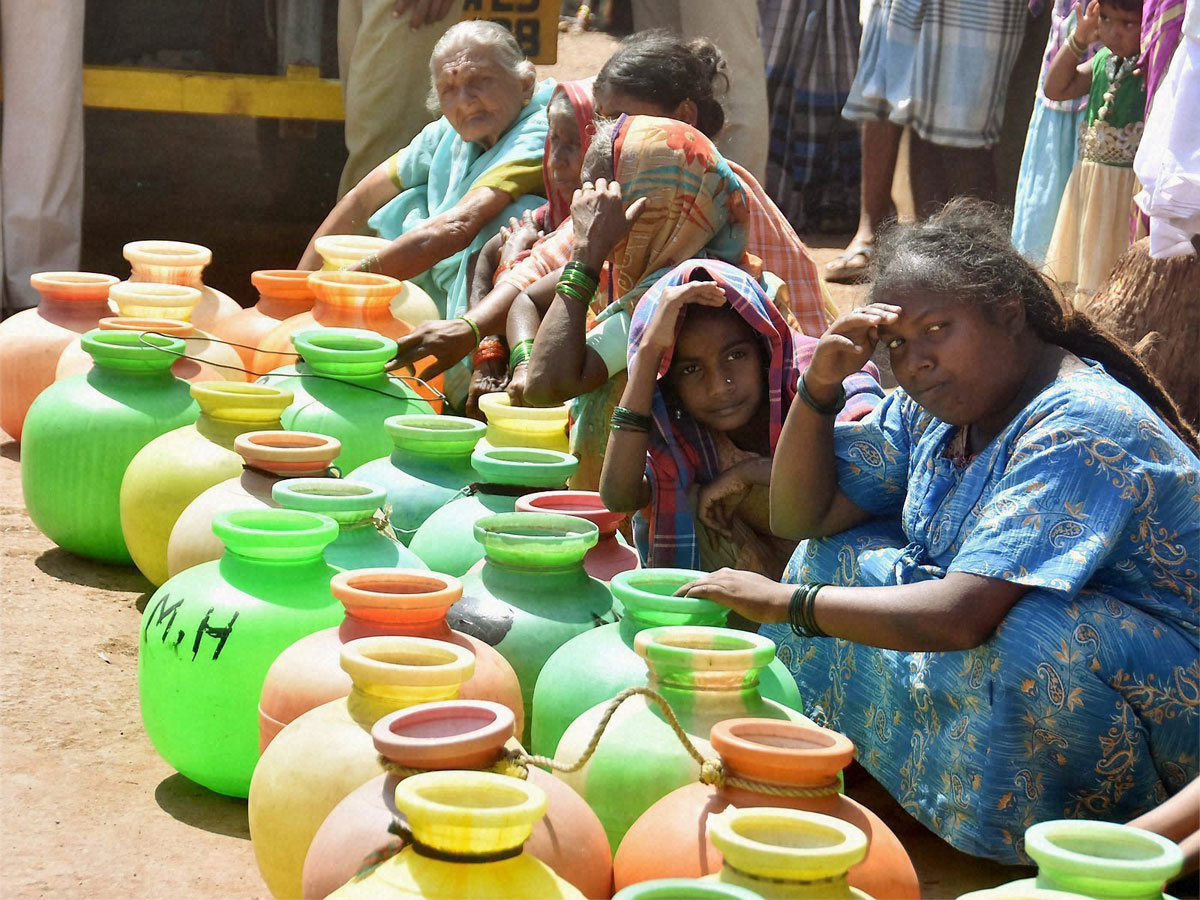INDIA’S WORSENING WATER WOES
People wait with their pots to collect water at drought-hit Bhandivad village in Hubli, Karnataka, April 26. (Press Trust of India)
India’s water woes are worsening as the country reels under the spell of a second successive drought. This is one collective problem that unites the 330 millions residing in 256 drought affected districts spread over 10 states with large swathes of the world’s driest continent facing the worst summers, writes Priyanka Bhardwaj. (@siliconeer, #siliconeer, #india, #watercrisis, #Indiadrought, #indiafarmersuicide)
Official reports peg the number of deaths due to the intense heat to 300, of which more than half have occurred in the eastern state of Odisha that reportedly receives a fair amount of monsoon rains.
While the Indian Metrological Department warns that temperatures would top 45˚C (113˚F) at most places, Indian Water Resources Ministry also reports of huge dips in water levels of major reservoirs.

In the week ended April 21, 91 major rivers were left with just about 34.082 billion cubic meters (BCM) or 22% of their total water capacity, which is 157.799 BCM.
Compared to last year the levels have submerged by 35% and on a ten year average, the storage levels has decreased by 24%.
Andhra Pradesh and Tripura are the only two states to have reported higher water storage, while West Bengal has reported the same storage level as last year.
In the states of Himachal Pradesh, Telangana, Punjab, Odisha, Rajasthan, Jharkhand, Gujarat, Maharashtra, Uttar Pradesh, Uttarakhand, Madhya Pradesh, Chhattisgarh, Tamil Nadu, Karnataka and Kerala, the water shortage has been so enormous that small and marginal farmers have resorted to selling their cattle, used for farming and dairy purposes, at throwaway prices or migrating to other regions or cities.

In fact the 450,000 population of Latur in Maharashtra is surviving on a once a month supply of water as the drought has claimed the only dam in that area.
If it is true that nature’s fury is the primary reason for the dismal state of affairs, the blame can be attributed to drying up of traditional ponds and water bodies due to indiscriminate ravaging of groundwater reserves by indiscriminate growth of industries and pursuance of unsustainable, water-intensive agriculture.
In Maharashtra, among the worst-affected states and to have witnessed a high rate of farmer suicides in past two decades, a debate is raging over using water for irrigating sugarcane or for beer-making rather than saving what’s left for drinking purposes.
This seems to be among the worst droughts as one witnessed public outcries over a politician, Pankaja Munde, Rural Minister of Maharashtra clicking a selfie on a tour of the parched regions of the state or for water wastage as in Karnataka where water tankers sprayed a dusty road before the Chief Minister’s arrival.
A month ago when the Indian Premier League cricket matches were in full swing, a barrage of Public Interest Litigations forced the Indian Courts to order the shifting of 13 matches out of Maharashtra to venues in other states.
Closer to the national capital, the state of Haryana’s Chief Minister Manohar Lal Khattar has ordered 2,000 tankers of Public Health Engineering and Urban Local Bodies Departments to be deployed for ensuring adequate supply of drinking water in the water-deficient villages and has directed use of drinking water for purposes like washing cars, gardening, and in construction works to be made punishable.

In February the Jats’ agitation for reservation in Haryana-Delhi had witnessed the destruction of the link of the Munak water channel to the national capital and the forcible shutting down of seven treatment plants by protestors thus affecting large parts of Delhi.
Though the government shut down schools and rationed water supplies yet there was no permanent solution arrived at.
Unbelievable as it may sound, the dry parts of the most populated state, Uttar Pradesh, has people eating rotis with salt or those made of grass!
The government claims that it has embarked on ambitious relief projects such as restoration of water tanks, redesign of irrigation works, opening of grain centers, continuance of mid-day meals in schools, shutting of schools for summers, etc., yet the delays in payment of wages and intense heat is keeping the laborers away.
The environmental NGO, Greenpeace has issued a warning to the government to accept its loopholes in policy that failed to treat groundwater as a finite resource because of which the per capita availability of water which was 5177 cubic meters in 1951 is down to 1545 cubic meters as per 2011 census.
This also explains why a country with over 75% labor force employed in the agricultural sector, experiences a daily statistic of 2,000 bread growers giving up farming for even menial jobs and reporting about 300,000 farmer-suicides since 1995.
Amidst all kinds of distressing news, there are two pieces of news to cheer and learn from: the Jaislamer district of desert state of Rajasthan has reported a bumper crop yield of Rs. 3 billion due to a continuous flow of water through the Indira Gandhi Canal.
Another one is the exemplary effort of the villagers of Hiware Bazar in Maharashtra who have raised their groundwater levels to just about 20-40 feet below surface.
Since 1994 this village worked as a unit on a set program of watershed management, water conservation and alternate agricultural pattern technique to arrive at a point when they do not need to rely on rains or water tankers.
And the credit for this goes to the villagers alone and not the government.
In summation, till concrete, sustainable measures provide some resolution, the struggle for water is only expected to aggravate though for this year a bounty rainfall is a glimmer of hope, as predicted by some weather experts.


